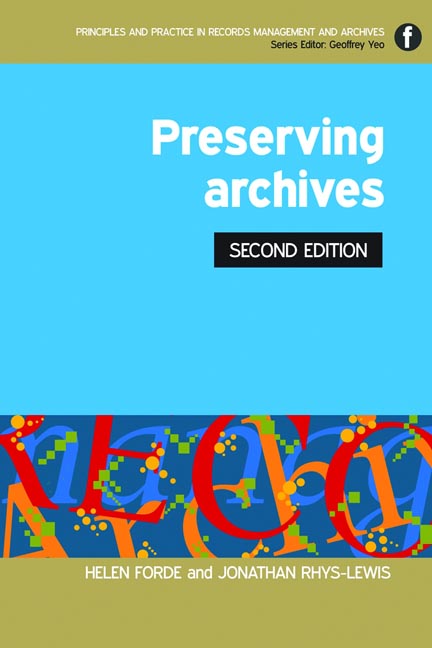Book contents
- Frontmatter
- Contents
- Introduction to the series Geoffrey Yeo
- Preface to the Second Edition
- Acknowledgements
- 1 Introducing archive preservation
- 2 Understanding archival materials and their characteristics
- 3 Managing digital preservation
- 4 Archive buildings and their characteristics
- 5 Safeguarding the building and its contents
- 6 Managing archival storage
- 7 Managing risks and avoiding disaster
- 8 Creating and using surrogates
- 9 Moving the records
- 10 Exhibiting archives
- 11 Handling the records
- 12 Managing a pest control programme
- 13 Training and the use of volunteers
- 14 Putting preservation into practice
- Appendices
- Bibliography
- British and international standards relating to archive preservation
- Index
12 - Managing a pest control programme
Published online by Cambridge University Press: 09 June 2018
- Frontmatter
- Contents
- Introduction to the series Geoffrey Yeo
- Preface to the Second Edition
- Acknowledgements
- 1 Introducing archive preservation
- 2 Understanding archival materials and their characteristics
- 3 Managing digital preservation
- 4 Archive buildings and their characteristics
- 5 Safeguarding the building and its contents
- 6 Managing archival storage
- 7 Managing risks and avoiding disaster
- 8 Creating and using surrogates
- 9 Moving the records
- 10 Exhibiting archives
- 11 Handling the records
- 12 Managing a pest control programme
- 13 Training and the use of volunteers
- 14 Putting preservation into practice
- Appendices
- Bibliography
- British and international standards relating to archive preservation
- Index
Summary
Introduction
Threats to materials in archives, libraries and museums include infestation by pests, defined as insects, rodents or mammals which find the warm, dark conditions attractive. The damage caused can be considerable and in some cases catastrophic; not only can pests devour the displays and the materials from which artefacts are created, they may also threaten the structure of the building in which they are housed. This chapter looks at:
• the most commonly found pests in the UK
• how to recognize them
• what damage they do
• where they are likely to be found
• the signs of an infestation
• how they can be prevented
• eradication measures
• integrated pest management.
In the UK the incidence of very rapacious pests is currently small (a colony of termites found in 1999 in Devon has allegedly been eradicated) but in less temperate areas of the world they can be very destructive. Changing climatic conditions are likely to increase the likelihood of such infestation in northern Europe. An earlier tendency to assume that such outbreaks can be prevented or eradicated by the use of chemical pesticides or fumigants has been largely superseded by the adoption of policies which aim to be proactive rather than reactive and to avoid the use of substances which may be harmful to people and to the materials held in the archive or library. It is unlikely that any building will be able to keep all pests at bay; concentrating on as much prevention as possible and making the inside environment unattractive is therefore a more workable solution.
It is fair to say that most institutions would view an infestation or a mould infection of their collections as an acute embarrassment; this may have implications on existing funders and depositors or have wider local political impacts. However, all organizations will be affected by these phenomena and the profession can only move forward by sharing experiences and formulating credible responses.
What are the common pests?
They divide into vertebrates and insects. The most common verte brates to cause damage in archives and libraries are mice, rats, squirrels and birds. Occasionally other vertebrates such as rabbits gain entrance to collections, but it is unusual.
- Type
- Chapter
- Information
- Preserving Archives , pp. 189 - 202Publisher: FacetPrint publication year: 2013



